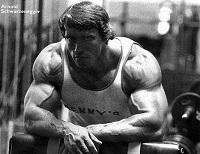THE Beast | Thu August 14, 2008
Great article!

August 09 2008
The most effective rep range for muscle growth? Strength and fitness organizations, exercise physiology textbooks, and fitness magazines have all gladly accepted 8-12 reps or repetitions as the scientifically established best rep range for hypertrophy or muscle growth.
But now it is ever so clear that the 8-12 reps range has nothing special besides some faulty science supporting it.
Now let’s see on what scientific basis this particular repetiton range was shown to be the best for muscle growth and where the so-called science gets unscientific.

Growth hormone (GH) is anabolic in nature.
Growth retardation is seen in Growth hormone (GH) deficient adults whereas increased growth is seen with over secretion of growth hormone. Gains in muscle and strength in growth hormone deficient individuals after growth hormone (GH) administration is commonly observed. Further, growth hormone (GH) is also shown to be effective in preventing muscle lose in catabolic conditions, like burns.
All the above observations easily lead to the assumption that GH plays a major role in muscle growth.
Since 8 - 12 reps were used by bodybuilders and 1 - 4 reps by powerlifters, the researchers suspected the 8-12 reps to be causing a greater release of GH than 1- 4 reps and thereby making those muscle bigger.
And guess what? As they suspected, a greater GH response was seen with moderate weight with short rest periods compared to heavier weight with longer rest period. For example, one study reported that performance of 20 sets of 1RM produced a slight increase in GH, whereas a substantial increase in GH was observed following 10 sets of 10 repetitions with 70% of 1RM.
And thus the 8-12 reps was scientifically proven to be the ideal rep range for muscle growth, and as they say the rest is history.
Now let’s look through some of the holes in the GH hypothesis:
Metabolic Stressors: Activities that stress the metabolic pathways like hyperventilation, breath holding, hypoxia and even nicotinic acid ingestion have been shown to significantly increase the secretion of GH.
And none of these activities has even remotely shown to increase or even help muscle growth. Have you? (1)
Correlation: Though 8-12 reps with shorter rest periods showed the greater GH release, it is only correlative evidence at best.
It does not necessarily mean that it is the increased GH that is causing the muscle growth. There could be many hormones and protein that are at a higher level or even at lower level that could affect muscle growth in appositive way. And mind you, there is no study to show 8-12 reps/repetitions to be better than other rep ranges for muscle growth.
GH Injection: The ideal method to study if the increase in GH indeed causing the increase in muscle growth is to inject Growth hormone (GH) and study the results.
Number of studies has looked at healthy older individuals with GH administration and exercise, but most of them showed no increase in muscle mass nor strength. The studies which did show an increase in lean body mass was revealed to be due to increase in water retention and connective tissue growth than actual increase in muscle. The same (or no effect) was also shown in young men and experienced weight lifters too (2, 3).
The inability off growth hormone (GH) even at physiological and at supra physiological doses to elicit muscle growth is more than enough evidence to doubt the efficacy of those tiny spikes of GH with exercise on muscle growth.
Local Growth Factors: The biggest blow to the GH hypothesis was the recent discovery of central role played by local factors in muscle growth. And these local factors are the reason why injecting GH and other methods to raise GH haven’t really worked as expected.
It is pretty clear now that these local factors, like MGF (Mechano Growth Factor) and IGF-1 (Insulin-like Growth factor) in the muscle can exclusively regulate muscle growth without any help from systemic GH. Animal studies have shown substantial increase in muscle growth even after the GH axis was surgically removed.
In humans, GH deficient adults and even elderly with low GH & IGF-1 levels are able to increase muscle mass with resistance training. These local factors are so potent that researchers have already been working with ant-doping committee to prevent MGF abuse. (I will write more about these local factors in upcoming articles) (4).
If anything above makes any sense, then there is no reason to hold on to 8-12 reps as the best or the most effective for muscle growth. No reason, as well, to hold on to practices, like breathing squats, 20 rep squats, and working out on an empty stomach to raise growth hormone and thereby gain some muscle.
Reference 1
Reference 2
Reference 3
Reference 4
Reference 5
Reference 6
Anoop | Thu August 14, 2008
Thanks for comenting.
I wrote it around 3 years back in another article. I just made it more readable with lot less references.
There are other issues like sarcoplasmic and sarcomeric muscle growth when we talk about rep ranges. I will write that some other time.
Jim @ Total Body Fitness | Tue February 10, 2009
Read you in depth article over at M & M.com and have enjoyed this article as well. Keep em coming.
Thanks
Anoop | Wed February 11, 2009
Hi Jim
Thanks for taking the time to comment.
Any feedback is appreciated.
© 2008 - 2024 | Exercise Biology. All rights reserved.